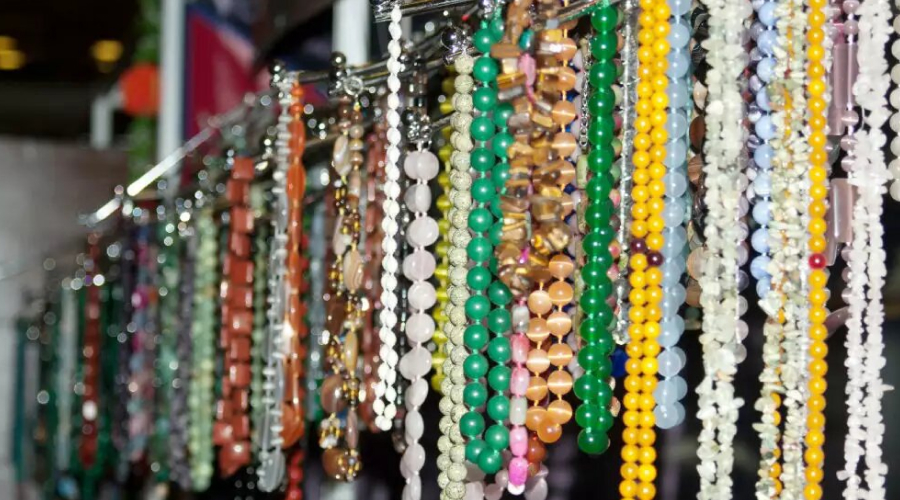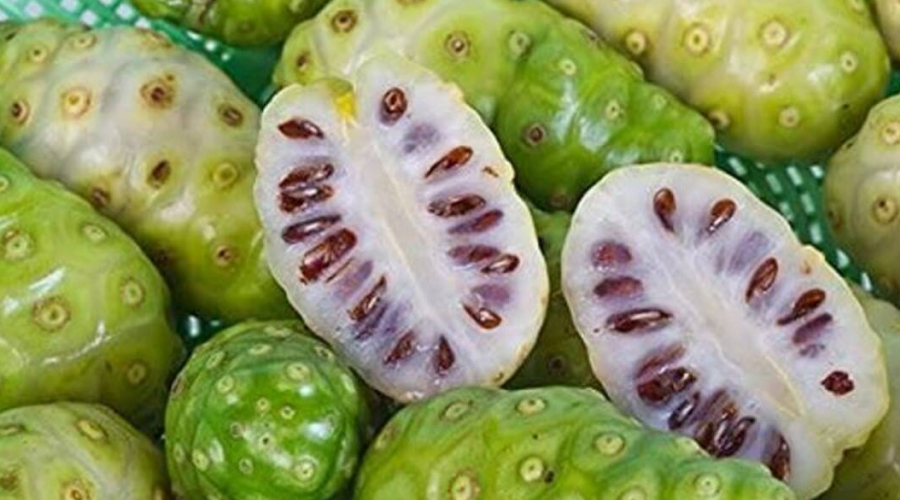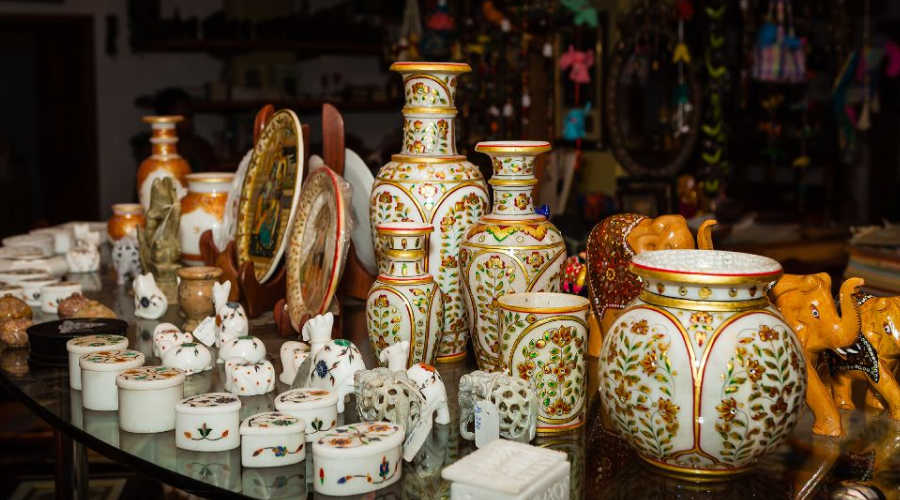Shopping in the Andaman Islands can be a delightful experience, offering a mix of local crafts, souvenirs, and unique items. Here are some popular items to consider when shopping in the Andaman Islands:
Suggested Read: Things to do in Andaman and Travel tips for Andaman
You can also the best shopping places in Andaman
Make Memories with Ornate and Cherished Shell Crafts of Andaman

The Andaman Islands are known for beautiful shell crafts. Items like shell jewellery, decorative pieces, and lampshades made from various types of shells are popular among tourists. In the Andaman Islands, shell crafts are a popular form of local art and the various items are crafted using shells collected from the abundant marine life surrounding the islands. These shell crafts showcase the creativity of local artisans and provide unique souvenirs for visitors. Artisans in the Andaman Islands create beautiful jewellery using a variety of shells. Necklaces, bracelets, earrings, and even anklets are crafted with different types and sizes of shells. These pieces often feature intricate designs and vibrant colours.
Decorative items like wall hangings, mirrors, and photo frames are adorned with shells. Artisans arrange shells in captivating patterns, creating eye-catching and aesthetically pleasing designs. Ornaments such as keychains, mobile charms, and figurines are crafted using shells. These small items make for affordable and charming souvenirs for tourists. Lampshades made from shells are another popular craft. The translucency of certain shells allows for a soft and beautiful glow when used as lamp covers. These lampshades often feature intricate patterns and designs. Coasters and placemats are crafted by arranging shells in patterns on wooden or fabric bases. These functional items add a touch of the Andaman’s coastal beauty to dining or coffee tables.
Local artisans incorporate shells into bags and purses, adding a unique and coastal flair to these accessories. The shells are often arranged in patterns or used as embellishments. Wooden boxes are covered with shells to create decorative and functional storage items. These boxes may be used to store jewellery, trinkets, or other small items. Wind chimes made with shells produce a soothing sound when the wind passes through them. These can be both decorative and functional. Buy these unique art pieces to add a touch of coastal charm to outdoor spaces. When purchasing shell crafts in the Andaman Islands, tourists are always guided to be aware of environmental considerations. It should be ensured that the shells used are sourced sustainably and are not part of protected or endangered species. Responsible shopping helps support local artisans while promoting the conservation of the marine environment.
You can check our customize Andaman Holiday Package.
The Attractive Wooden Crafts of Andaman

Hand-carved wooden crafts, including figurines, masks and traditional artifacts, showcase the local craftsmanship. Look for items made from durable and locally sourced wood. In the Andaman Islands, wooden crafts are a significant part of the local artisanal tradition. Skilled craftsmen use various types of wood to create a range of products, from functional items to decorative pieces. These wooden crafts often showcase the rich cultural heritage and craftsmanship of the region. Local artisans carve intricate designs and patterns into wooden items, such as figurines, masks and decorative panels. These carvings often depict elements of the islands’ flora, fauna and cultural symbols and represent the local culture. Skilled craftsmen in the Andamans create a variety of wooden furniture, including chairs, tables and cabinets. The furniture often features traditional designs and sturdy craftsmanship.
Wooden utensils like ladles, spatulas and bowls are crafted for both functional and decorative purposes. These items may feature hand-carved designs, making them unique and aesthetically pleasing. Artisans create small wooden souvenirs for tourists, including keychains, magnets and miniature carvings having cute and typical designs. These items often incorporate cultural and natural motifs. Wooden beads and pieces are used to create unique jewellery pieces. Necklaces, bracelets and earrings showcase the natural beauty of the wood while incorporating traditional and contemporary designs.
Wooden masks are carved with intricate details and vibrant colours, often representing traditional or mythological characters. These masks are used in cultural events and are also popular as decorative pieces.
Handcrafted wooden model boats, reflecting the maritime heritage of the Andamans, are popular among both locals and tourists. These boats showcase the craftsmanship and attention to detail of the artisans. Wooden boxes with carved or painted designs serve both functional and decorative purposes. These boxes are often used for storage or as ornamental pieces in homes. Wooden panels and wall art featuring carved or painted designs are used to enhance the interior decor of homes and businesses. These pieces often depict scenes from nature or cultural motifs.
Some craftsmen create traditional wooden tools used in fishing, agriculture or other local activities. These tools may have both practical and decorative value. Watch the craftsmen carving their art and encourage their artistry by purchasing wooden crafts in the Andaman Islands. Appreciate the craftsmanship and cultural significance behind each work of art. Supporting local artisans helps sustain traditional crafts and contributes to the cultural and economic well-being of the region.
Carry Back Some Bamboo and Cane Products

Bamboo and cane products are widely available in the Andaman Islands. These include baskets, mats, hats, and furniture. The indigenous Jarawa tribe is known for their skill in working with these materials. Local craftsmen create furniture items such as chairs, tables, and stools using bamboo. The lightweight and durable nature of bamboo make it an ideal material for furniture in the tropical climate of the Andamans. Cane baskets of various shapes and sizes are crafted for different purposes. These baskets are used for carrying and storing items, and they often feature intricate weaving patterns. Mats and rugs made from bamboo are commonly used in homes. These products provide a natural and eco-friendly alternative to conventional floor coverings. Artisans design and weave cane to create stylish and functional handbags and purses. These items showcase the versatility of cane as a material for fashion accessories. Traditional hats made from bamboo and cane are crafted for protection against the sun. These hats are popular among locals and visitors alike. Decorative screens and room dividers are made from bamboo and cane. These products serve both practical and aesthetic purposes, adding a touch of local craftsmanship to interiors. Cane is often used as an accent material in furniture, such as chair backs or tabletops. These accents contribute to the overall design while utilizing the natural properties of cane. Decorative items like lampshades, vases, and sculptures are crafted from bamboo and cane. These pieces often feature traditional motifs and designs. Traditional fishing tools, including fish traps and baskets, are crafted using bamboo and cane. These tools showcase the ingenuity of the local fishing communities. Walking sticks made from sturdy cane are crafted for both functional and decorative purposes. These items often feature unique designs and carvings.
Traditional umbrellas made from bamboo and cane provide shade in the tropical climate. These umbrellas are often used during cultural events and festivals. Small decorative items, keychains, and souvenirs are crafted from bamboo and cane, making for unique and locally inspired gifts. When purchasing bamboo and cane products in the Andaman Islands, it’s important to appreciate the sustainable and eco-friendly nature of these materials. Supporting local artisans who create these traditional crafts helps preserve cultural traditions and promotes environmentally conscious practices.
Watch Out for Pearl Jewellery

The Andaman Sea is known for its pearls. You would love to discover a variety of pearl jewellery, including necklaces, earrings and bracelets. It is recommended that you buy from reputable sellers to ensure authenticity. In the Andaman Islands, particularly around the region of Neil Island, pearl farming is a significant industry. As a result, you can find a variety of exquisite pearl jewellery crafted by local artisans. Pearl necklaces featuring pearls of varying sizes and shapes are a common and popular item. These may include classic single-strand necklaces or more intricate designs with multiple strands. Earrings adorned with pearls come in a range of styles. From simple pearl studs to more elaborate drop earrings, the pearls used can vary in colour and size. Pearl Bracelets can be found in different designs. They may feature a single strand of pearls or be combined with other materials like beads or metals.
Rings with pearls as the central gemstone are crafted in various styles. The pearls may be set alone or with any other gemstones or metals. Pendants with pearls are created to form a chain. These can be simple and elegant or more ornate in designs. Complete jewellery sets, including necklaces, earrings and sometimes bracelets or rings, are crafted with matching or complementary pearls. Many local jewellers in the Andaman Islands offer custom designs, allowing you to create personalized pearl jewellery tailored to your preferences.
The pearls found in the Andaman Islands are often cultured pearls, cultivated through pearl farming. These pearls are formed with the assistance of pearl farmers who insert a nucleus into oysters, stimulating the production of pearls. Pearls in the Andaman Islands can come in various colours, including white, cream, pink, and sometimes darker shades. The colour of the pearls is influenced by the type of oyster and the environment in which they are cultivated. Pearl Jewellery should be bought after considering the quality of the pearls, including factors like lustre, surface quality, shape and size. High-quality pearls will have a smooth surface and a bright, reflective lustre. When shopping for pearl jewellery in the Andaman Islands, it’s advisable to buy from reputable and established jewellers. Authenticity, craftsmanship, and fair trade practices are essential considerations when selecting your pearl jewellery.
Buy Some Local Spices

The Andaman Islands are home to various spices, and you can purchase locally produced spices such as black pepper, cinnamon and vanilla. These make for excellent gifts and souvenirs. Buying local spices in Andaman can anyways be a delightful experience. Happily explore and savour the unique flavours of the region. Visit local markets in major towns such as Port Blair, Havelock and Neil Island. These markets often have spice vendors selling a variety of local spices. Aberdeen Bazaar in Port Blair is a popular market where you can find such vendors. Government-run emporia and outlets often showcase and sell local products, including spices. The Andaman & Nicobar Government’s Directorate of Industries and Commerce may have outlets where you can purchase locally produced spices. Remember to be respectful of local customs and regulations when buying and transporting spices, especially if you plan to take them back home. Additionally, inquire about the best ways to store and use the spices to enhance your culinary experiences with the unique flavours of Andaman.
Taste the Tropical Fruits

Purchase and indulge in the taste of local tropical fruits and spices to take home a touch of the Andaman Islands. Items like dried fruits, jams and spice blends can add a burst of flavours to your daily meals.
Andaman’s Coconut Shell Products Make Beautiful Souvenirs

Coconut shell is creatively used to make items like bowls, cups and other decorative pieces. These eco-friendly products showcase the resourcefulness of local artisans. Skilled artisans carve and shape coconut shells into bowls and cups, creating unique and eco-friendly kitchenware. Even coconut shell spoons and ladles are crafted for use in the kitchen. Intricate designs are carved out of coconut shells to create beautiful candle holders, providing a rustic and decorative touch. Artisans in the Andaman Islands often use coconut shells to create stylish and lightweight jewellery pieces, incorporating traditional designs or modern styles such as coconut shell earrings that are popular for their natural and earthy appeal. Home decor items such as coasters made from coconut shells and wall art made from coconut shell pieces are common. Animal figurines and traditional masks reflect the cultural and environmental richness of Andaman islands.
Intricately Woven Traditional Nicobari Mats

The Nicobari tribe on the Nicobar Islands is known for its traditional mat-making skills. Nicobari mats, woven from natural fibres, are intricate and unique. They are typically handwoven and are created using a coil weaving technique that results in sturdy and durable products.
Explore the Local Handicrafts and Tribal Artifacts Market

Explore local markets for a variety of handicrafts, including pottery, tribal jewellery and handwoven textiles. These items often reflect the cultural diversity of the islands. You can also explore the artifacts and replicas representing the indigenous cultures of the Andaman and Nicobar Islands, as well as the Jarawa and Nicobarese tribes.
Local Clothing and Fabrics
Traditional clothing and fabrics, often featuring vibrant colours and patterns, can be found in local markets. These make for comfortable and culturally rich souvenirs.
Conclusion
While shopping in the Andaman Islands, explore the local markets and interact with artisans to feel the richness of the region’s culture.

